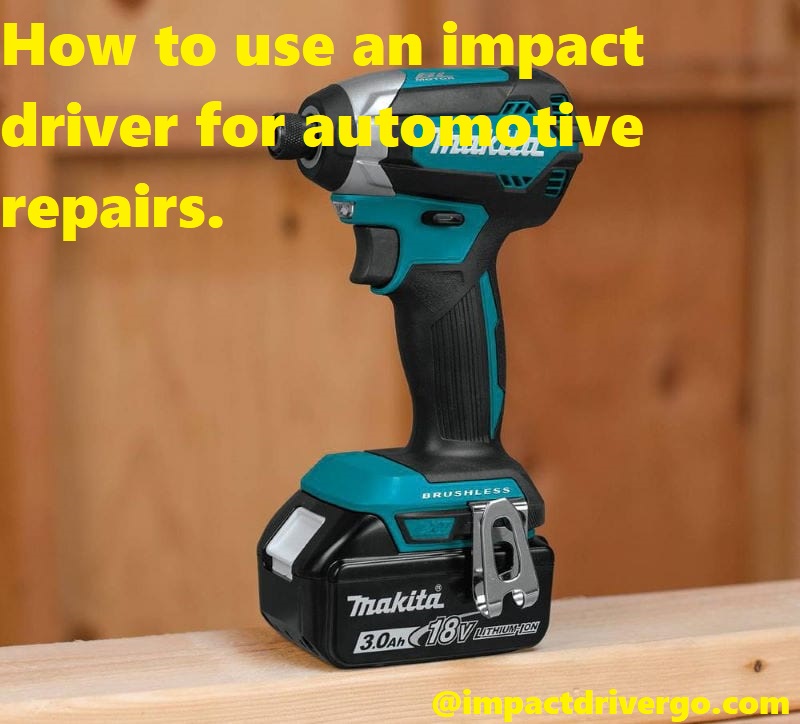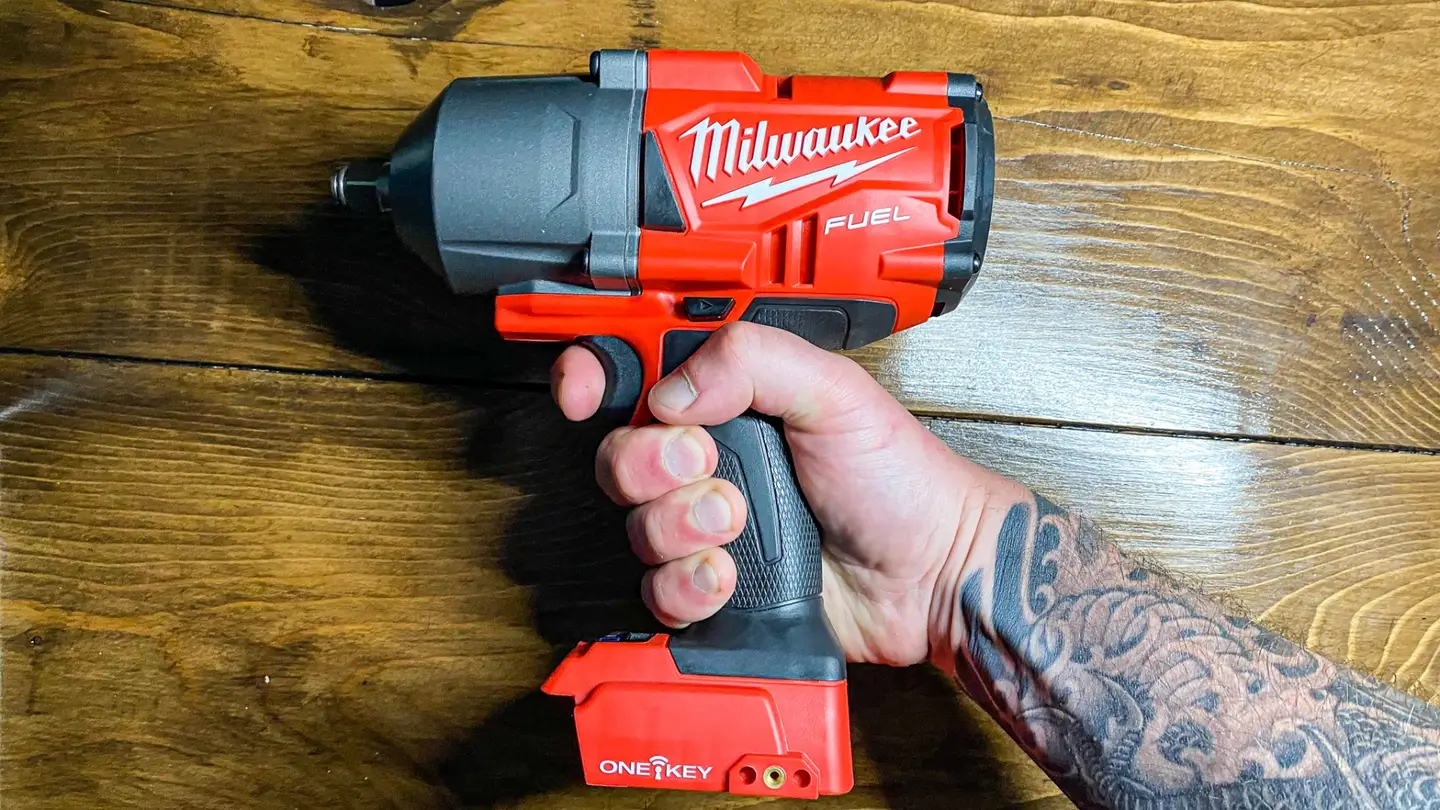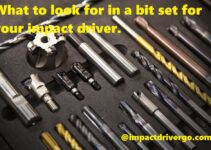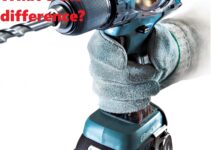Are you having a hard time fixing your car? Worried that your regular screwdriver just isn’t enough? An impact driver can be the answer you need!
You can use it to easily repair and maintain your vehicle. This guide will show you how!
The impact driver has become a staple piece of equipment in many automotive repair workshops. An impact driver is an essential item for those who are serious about carrying out automotive repairs, as it offers greater control and precision than regular power drills and screwdrivers. An impact driver is also capable of sinking or tightening large bolts or screws that would be difficult to do with a drill or traditional screwdriver.
In this guide, we will discuss the basics of using an impact driver for automotive repairs and provide some tips on how to get the most out of your new tool.
We’ll begin by discussing what an impact driver is and how it differs from a standard drill. We’ll then explore different types of bits that are compatible with the tool and discuss their best uses in automotive repair applications. Finally, we will talk about safety protocols you should be aware of before beginning any work with an impact driver. After reading this guide, you will be ready to start taking on basic automotive repair projects with confidence!
Explanation of what an impact driver is
An impact driver is a powerful hand-held tool used for driving screws and other fasteners. It works by using a combination of force, torque, and vibration to drive the screws into hard surfaces.
The tool is designed to provide high speed, low vibration operation while still delivering great amounts of torque that are perfect for automotive repairs and maintenance. Impact drivers can also be used with all types of bits including square drives, Phillips heads, Torx, hexagonal heads and many others.
By providing controlled torque over the entire length of the screw’s thread pattern, these tools create uniform pressure on the fastener which makes them an invaluable element in any auto mechanic or DIYer’s toolkit.
Types of Impact Drivers
Impact drivers come in two main types: cordless and corded. The most common type of impact driver is the cordless model, as they are easier to maneuver and use in tight spaces. Cordless impact drivers often employ rechargeable batteries, however some models can be used with regular alkaline or lithium-ion batteries. Cordless impact drivers are usable in various positions, whether you’re working on a large repairs job or a small one.
Corded impact drivers usually run on electricity and deliver more sustained power and torque than the battery-powered models. While they may not be as mobile as the cordless options, they have their advantages: their power source makes them ideal for larger tasks that require longer periods of use. In addition, these impact drivers tend to be more powerful than their battery-powered counterparts and possess greater torque ratings as well.
Explanation of the different types of impact drivers
There is a variety of impact drivers available in the market. They are categorized based on the type of drive or material being used. When selecting an impact driver for automotive repairs, it is important to consider the power requirements, torque requirement and type of drive needed for your particular repair task.
The three most common types of impact drivers include electric, pneumatic, and manual. Each one offers unique advantages and disadvantages that must be taken into account when performing complex repairs such as automotive jobs.
Electric impact drivers are generally more powerful than manual ones and have longer run times than pneumatic drivers. Electric impact drivers run on electric motors which can be powered by batteries or connected to the car’s power supply system. Electric motors have great torque output making them suitable for heavy fastening applications such as common automotive repairs like wheel lug nuts and engine bolts. They also come with various speed settings and they can produce RPMs ranging from 200-3000 RPM depending on the model purchased.
Pneumatic impact drivers are powered by compressed air from an air compressor or a separate tank which gets connected directly to the driver tool. Pneumatic tools offer more consistent accuracy than electric models since air is released in a constant stream making them ideal for precision work when working with delicate fasteners such as plastic engine coverings or fuel lines that may require multiple fittings or removal https://sitenationbdmachineshopcom/2020/impact-drivers-in-automotive-repair/. Pneumatic control also makes these tools highly efficient reducing fatigue during repetitive jobs like loosening stuck nuts and bolts that would otherwise require a lot of elbow grease with manual tools https://wwwideahackscom/impact-driver/, where accuracy is paramount due to tight fitting components found in cars engines https://carthrottlecom/post/why-are-car….
Pneumatic Impact Drivers deliver consistent torque output regardless of conditions such as when fasteners are extremely corroded, damaged or gritty which makes them invaluable in circumstances like car engines that have been left neglected over time http://wwwgc3toolscom/blogs/advantages….
Manual impact drivers operate via mechanical force delivered through turning handles with knobs instead of levers like other types dohttps://wwwglobaltoolingorg/2019/09/26…. As a result, they will require higher level strength outputs from the user but their systems provide greater repeatability when precisely screwing together threads eventually making it possible to reassemble perfectly balanced wheels http://autotoolsdirectcouk/blog//how–perfectly –balance–wheels–impact–driver/. Additionally manual impact drivers tend to be much lighter than electric models due to fewer number of moving parts https://tradessupermarketcouk//best –impcat–drivers.
Comparison of the different types of impact drivers
Impact drivers come in a range of types, shapes and sizes, so it can be a bit confusing to determine which one is best for the particular task you have at hand. There are several factors that go into selecting the right tool for the job and it’s important to understand each type of impact driver in order to make an informed decision.
The three most common types of impact drivers are cordless drill/drivers, air impact wrenches and electric impact wrenches. Each type has distinct advantages and disadvantages over another, depending on what type of project you’re working on.
Cordless Drill/Driver: Cordless drills offer great speed and convenience when working on small projects, such as screwing in bolts or removing small nuts or bolts that don’t require a lot of torque or power. The downside is they can be limited in terms of precise control when trying to start the power drill without slipping or accidentally driving too far into a component.
Air Impact Wrench: These typically require use with an air compressor, meaning they should only be used for longer projects requiring precision torque levels that need not only speed but also precise control over how much force is applied during operation. Their unique design provides nearly instantaneous turning force which makes them ideal for tight spots where a standard drill just won’t do the job properly. They can also provide more torque than cordless drills, making them more ideal for bigger jobs that require greater force and precision control than a cordless could provide.
Electric Impact Wrench: Electric impact wrenches are powered by electricity, so they don’t need an outside source such as an air compressor like their air-powered counterparts do – great for convenience if you don’t already have one at home! They also provide great variable speed control depending on your needs; however they may be less powerful than either the air powered or cordless variety – so this is something to consider accordingly before making a purchase decision based off of power alone!
Choosing the Right Impact Driver
When it comes to repairing automotive components, an impact driver is a tool that can save you a lot of time and effort. An impact driver is a power tool that uses reversible rotation, along with forward and backward pulses, to drive fasteners into a variety of materials. While some impact drivers are self-contained, others are part of drill/driver combinations for more convenience. In this guide, we’ll discuss the various types of impact drivers as well as how to choose the best one for your automotive repair project.
Impact Drivers: An Overview
An impact driver uses two different types of motion: rotational motion and hammering motion. This allows an operator to quickly and easily drive in screws or bolts with minimal effort and can also be used in reverse to loosen already-installed fasteners. Impact drivers come in two main categories – corded drills and cordless drills. Each type has its own unique advantages depending on your working environment or budget requirements.
Corded Drills: These are ideal for single-location jobs where outlets are readily available or when working outdoors on a job site or garage with portable generator power. They provide consistent power while protecting you from any fluctuations in voltage stemming from generators or heavy-duty extension cords running from outlet to outlet.
Cordless Drills: Cordless drills offer more portability than their corded counterparts but require frequent battery changes so it’s important to consider how much time you plan on spending working with an impact driver before making your purchase decision). Cordless drills also typically offer variable speed settings so you can fine-tune the operation based on what type of material (wood, metal, etc.) you’re driving into—helping ensure accuracy during your repair job!
Factors to consider when choosing an impact driver for automotive repairs
When choosing an impact driver for completing automotive repairs, several factors must be taken into consideration. Depending on the needs of the job, a variety of impact drivers are available at varying price points. Some of the most important factors include battery life, speed, torque range and size.
Battery life and battery type are essential for any impact driver used for automotive repair. Lithium-ion batteries offer superior performance with improved run-time when compared to their nickel-cadmium counterparts. Most digital guides list both battery type and estimated run-time to assist consumers in their purchase decision.
Speed is another important factor to consider when selecting an impact driver for automotive repair work. Speed settings may range from 0–2500 RPM depending upon the model chosen. Many users opt for higher RPMs in order to quickly complete difficult jobs before needing to recharge or replace batteries mid task.
The torque range is also highly relevant when looking for an appropriate impact driver for auto repair and maintenance activities. During operation, torque is transferred from the motor to the bit tip and can range from 200–2800 lbs/inch with certain models containing special torque settings for specific tasks such as driving screws into metal sheets or parts requiring higher resistance points. Often users appreciate having a wide array of torque levels available as it makes it easier to adjust accordingly without stripping bodywork bolts or overtightening fasteners too quickly in one swoop causing them to break off or malfunction altogether post installation/repair work completion.
Lastly, size also comes into play while selecting an appropriate tool as many users will prefer heavier duty tools capable of carrying out larger jobs requiring increased power but do not take up too much room on their respective shop shelves/areas during storage times between rebooting tasks upon completion of a continuous job order list issued by customers. Over time this factor becomes increasingly important enabling technicians (or hobbyist car enthusiasts) to properly store their settings yet still allow enough room in case new tools ever need acquisitioning due additional changing product evolution paradigms which require the utilization of more challenging types support elements spanning multiple areas combined together in unison within same task execution scenarios expected by ever increasing consumer demand shifts seen throughout respected industry today inspiring future development ideals/concepts outlined daily by car manufacturers across whole world respectively moving forward collectively over course each scheduled year.
Using an Impact Driver for Automotive Repairs
- Using an Impact Driver for Automotive Repairs
Impact drivers are incredibly useful tools for automotive repairs. When working on vehicles, vehicle components like brake discs, suspension arms, and suspension links can become difficult to remove from their rusty mountings. An impact driver can be used to break through these stubborn nuts and bolts with a minimum of effort. Here’s how to use an impact driver for automotive repairs:
- Make sure the area you are working in is well-lit and that you are wearing work gloves and safety glasses.
- Select the appropriate bit for the job: A Phillips bit or a flat head bit can typically be used to loosen stuck nuts and bolts in automobile repairs.
- Position the bit into the head of the screw or bolt and gently press it against it until it is securely tightened in place.
- Turn on the impact driver by either pressing its power button or pulling its trigger repeatedly (depending on which type of tool you have). The impact driver should produce a loud, hammer-like sound as it loosens the bolt/screw with each pull of the trigger/press of the button, until it is fully freed from its rusty mountings.
- For hard-to-reach corners, consider using an adapter set that will enable you to attach extension bars or flexible extensions onto your impact driver. This should allow you access to tight spaces that would usually be difficult to get at without specialized tools or hours spent laboriously wrenching them loose manually!
- Once your stuck fasteners have been successfully loosened, use your chosen wrench type (ratchet spanner or adjustable wrench) to turn any unmovable rust residue off before replacing new fasteners into place with hand-tightened pressure only – an impact drill will not be able to tighten them correctly afterwards!
Step-by-step guide on how to use an impact driver for various automotive repairs, such as changing tires, replacing brake pads, and fixing suspension components.
An impact driver is a powerful tool that can make various automotive repairs much easier and quicker than with a regular screwdriver. Impact drivers use concussive force to turn and loosen or fasten screws, nuts, and bolts. Due to their heavy-duty power, they are especially useful for tasks like tire replacement, brake pad replacement, suspension component repairs, and any job where you need to secure or remove large amounts of bolts.
Before using an impact driver, it’s important to understand how they work and how to properly set them up for the task at hand. Here is a step-by-step guide on how best to use an impact driver for automotive repairs.
Step 1: Set up the Impact Driver: Place the correct bit in the driver head and tighten it so that it does not move freely in either direction when tested. For exact torque settings (amount of pressure needed), consult the owner’s manual of your specific model as different brands will have different buying requirements.
Step 2: Start off Slow: When using an impact driver on large screws or bolts it’s easy to put too much pressure which can cause the fastener to strip or otherwise damage your application. To avoid this, start off at a slower speed then gradually increase pressure until you feel just enough resistance for proper tightening.
Step 3: Use Safety Gear: Always wear safety goggles when working with higher torque levels on nuts or bolts as flying debris is a potential hazard with these types of jobs. Also consider wearing ear protection if you’re running your drill at high speeds because they can get very loud when used incorrectly! Additionally make sure that nothing else is nearby that could be damaged by being struck by flying pieces which often results from over-tightening fasteners.
Step 4: Loosen Old Parts: When replacing parts like brake pads or suspension components it’s important to first loosen any existing nuts/bolts before attempting installation of the new part(s). When working in tight spaces especially pay attention as some nuts may need special wrenches/socket attachments since impacts don’t always have enough clearance due to their size.
Step 5: Test Tightening Levels Regularly: As mentioned above, one of the most common problems when using an impact driver is overtightening due to excessive torque applied during operation.. If possible check existing nut/bolt tightness regularly while using your drill by giving them a gentle twist with your fingers – if everything feels secure then no further action needs taken but if you feel any give then take steps to tighten more appropriately without damaging anything else around them!
Safety precautions to keep in mind when using an impact driver
When using an impact driver for automotive repairs, it’s important to consider the safety hazards associated with the tool. Impacts from the driver can create sparks, debris and noise that can be dangerous to the user. To ensure your safety and that of those around you, here are some safety precautions to keep in mind when using an impact driver:
-Wear eye protection when using the impact driver as it can discharge debris at high speeds.
-Do not attempt to use an impact driver in hazardous environments such as near gasoline or other flammable materials.
-Ensure that all moving parts of the impact driver are properly lubricated before use.
-Be aware of working conditions such as temperature and humidity, which may affect how the impact driver operates.
-Never leave a running impact driver unattended; turn off this tool immediately after use.
Maintenance and Care for Impact Drivers
The key to using an impact driver safely, effectively, and for the longest period of time is maintenance and care. Here are some basic tips for getting the most out of your impact driver.
Clean the tool regularly – Impact drivers collect dirt and dust, which can cause moving parts to become jammed or worn out from overuse. A weekly wipe down with a clean rag can reduce this buildup and make sure you get the most out of your driver.
Replace worn bits – Because of their high torque output, impact drivers require more wear-resistant bits than traditional drills do. Unfortunately, with heavy use even these bits have a limit; replace them anytime they show signs of wear or damage.
Oil moving parts – Just like any other piece of machinery, oiling your impact driver’s moving pieces will ensure smooth operation and prevent unnecessary wear or tear. Consult your owner’s manual for the best type of oil to use on your specific model.
Fleet inspect regularly – Even with proper care an impact driver can suffer damage due to general wear and tear over time, especially when used in automotive settings where heat is constantly generated. Performing regular fleet inspections is key to ensuring that all safety guidelines are being followed as well as ensuring optimal performance from each tool in the fleet.
Tips for properly maintaining and caring for an impact driver
Using an impact driver can make automotive repairs faster and easier. To get the most use out of an impact driver, proper maintenance and care is essential. Here are some tips for making sure your impact driver stays in good working condition:
- Read and understand the manufacturer’s instructions. Make sure to familiarize yourself with the instructions before using the tool so you are aware of any safety precautions or special settings it may require.
- Clean your impact driver after each use and lubricate all moving parts according to the manufacturer’s instructions to avoid wear and tear on components.
- Inspect your impact driver regularly for signs of damage or wear that could diminish its performance or be a safety hazard when operating the tool. Replace damaged parts immediately if you notice any issues with your tool’s performance or functionality.
- Store your impact driver in a dry, temperature controlled environment away from direct sunlight, moisture, or dust accumulation when not in use, to maintain its performance over time.
- Make sure all nuts, bolts, and other fasteners are securely attached before operating your tool to ensure proper torque settings while performing automotive repairs with it.
Importance of regular maintenance to ensure longevity of the tool
Maintaining your impact driver regularly is essential to ensure it works efficiently and effectively. Any type of maintenance, off-season storage and safety precautions can help prolong the performance of the tool.
Regularly checking for and removing built-up dirt will increase the life of the tool. This includes wiping down the housing, inspecting moving parts, lubricating components and analyzing the function of all switches. You should also inspect all parts for any signs of wear, including bits and accessories. This can help you identify when it’s time to replace them so you don’t end up damaging your impact driver with a worn part.
You should also check for any loose screws or bolts, making sure everything is nice and tight before using your impact driver again. Not only that, but you should always keep your cordless impact driver in its carrying case when not in use to protect against dust, debris and corrosion that could lead to damage over time. Additionally, make sure it has fully charged batteries before each use to prevent overworking their motors or wearing down battery life prematurely.
Conclusion
To conclude, the impact driver can be an invaluable tool for automotive repairs. It will save you considerable time, reduce fatigue, and increase accuracy when compared to using more traditional power tools.
There are a few things to consider before using this type of tool in order to ensure safety while working on your vehicle. Before beginning any repair job, make sure you are aware of the safety protocols involved with using an impact driver and have all the necessary tools and components at your disposal.
With proper care, maintenance and understanding, this convenient tool can help you tackle automotive repair jobs quickly and easily.
FAQs
Can an impact driver be used for automotive?
Yes, an impact driver can be used for automotive work.
Why do mechanics use impact drivers?
Mechanics use impact drivers because they provide high torque output and are ideal for loosening stubborn bolts and nuts.
Is an impact driver better than a drill for automotive work?
Yes, an impact driver is better than a drill for automotive work because it provides higher torque output and is more effective at loosening stubborn bolts and nuts.
How much torque do I need in an impact wrench for automotive work?
The amount of torque needed in an impact wrench for automotive work depends on the specific task. Generally, a torque range of 100-400 ft-lbs is sufficient for most automotive work.
When should you not use impact driver?
An impact driver should not be used for delicate or precision work, as it can easily damage the material being worked on.
What is the difference between an impact driver and a wrench for automotive?
An impact driver is designed for driving screws and bolts, while an impact wrench is designed for loosening and tightening nuts and bolts.
What kind of impact wrench for automotive work?
A pneumatic impact wrench is the most common type of impact wrench used for automotive work.
What torque do car mechanics use?
Car mechanics use a range of torque settings depending on the specific task, but typically use a torque range of 50-250 ft-lbs.
What PSI is needed for impact wrench?
The PSI needed for an impact wrench depends on the specific model, but most require a minimum of 90 PSI.
Are impact drills used for cars?
Impact drills are not commonly used for automotive work, as they are not designed for high torque output and are not as effective at loosening stubborn bolts and nuts.
See Also-
- Best impact driver for automotive use
- Best impact driver for mechanics
- Best impact driver
- Best impact driver for lug nuts
- Best makita impact driver

